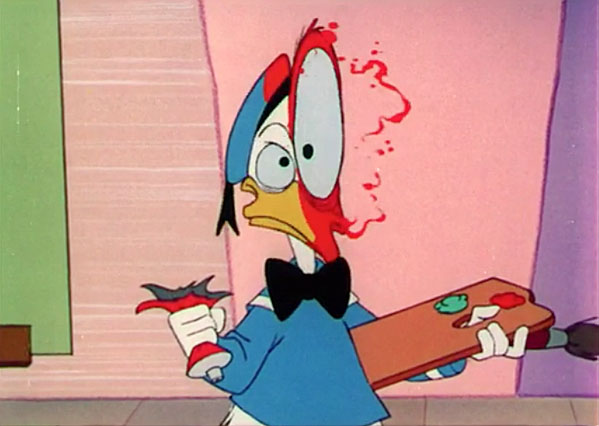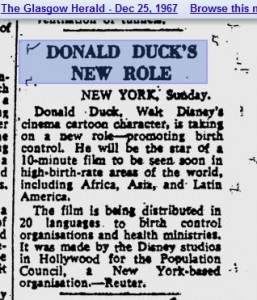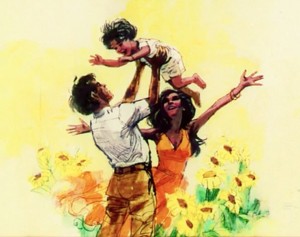
Walt Disney Educational Media released many Disney shorts as ‘Educational’, and produced quite a few films as well that were meant only for the educational market; several of these are somewhat rare, and this is one of them.
 Family Planning (1967), produced by Walt Disney productions for the Population Council, is perhaps the second oddest of the films that the studio produced for this market. VD Attack Plan (1968) is probably the winner in this particular category, with an especially graphic ending featuring real photos. It’s a jarring switch from the overall goofy and modern designed characters that otherwise populate that short.
Family Planning (1967), produced by Walt Disney productions for the Population Council, is perhaps the second oddest of the films that the studio produced for this market. VD Attack Plan (1968) is probably the winner in this particular category, with an especially graphic ending featuring real photos. It’s a jarring switch from the overall goofy and modern designed characters that otherwise populate that short.
It’s interesting to see somewhat extravagant production given to a minor educational short in both of these cases, especially considering the animation quality that was appearing in other educational shorts of the same vintage. While not to a feature standard, it’s certainly not an inexpensive short. I guess that was the Disney way.
The film is director by veteran Disney animator Les Clark. Art Direction by Ken O’Connor, Music by Buddy Baker. credited for animation are Cliff Nordberg, Art Stevens and Jack Boyd; with backgrounds by Bill Layne.
A very misplaced Donald Duck introduces the idea is his usual frantic, kid friendly way. it seems as if Donald isn’t even aware of the production he’s in, or at least no idea of what he’s presenting. His presence is there of course to bring us into the film and establish some familiarity, and he interrupts throughout out with ‘humorous’ interludes. Thes include the hilarity of being splashed in the face with paint. Maybe his star power worked well many years earlier in the War shorts The New Spirit and Spirit of ’43, but here it seems at odds with the rest of the film.
 Early on, the film tries really tries hard to be ethnically sensitive and easy for people of many cultures to understand by combining people of all sorts of ethnicities into a single couple- resulting in what looks like an Indian couple. The character design feels to me as if they’re designed for children, as if they could appear in an ‘It’s a Small World’ storybook. The woman character doesn’t speak- whispering into her husband’s ear rather than addressing our unseen narrator. Around three minutes in, this non-threatening cartoons universe is interrupted by realistic Illustrations that look like they’re from a religious pamphlet rather than a Disney short. The first of these, featuring a dead woman lying in the street among the nearly dead, is disturbing at best, and it’s followed by a child in nearly the same position.
Early on, the film tries really tries hard to be ethnically sensitive and easy for people of many cultures to understand by combining people of all sorts of ethnicities into a single couple- resulting in what looks like an Indian couple. The character design feels to me as if they’re designed for children, as if they could appear in an ‘It’s a Small World’ storybook. The woman character doesn’t speak- whispering into her husband’s ear rather than addressing our unseen narrator. Around three minutes in, this non-threatening cartoons universe is interrupted by realistic Illustrations that look like they’re from a religious pamphlet rather than a Disney short. The first of these, featuring a dead woman lying in the street among the nearly dead, is disturbing at best, and it’s followed by a child in nearly the same position.
The film seems to be aimed at rural population in third world countries in some respects, with a simple message basically explaining how to have less children. Although I don’t have the information as to where it was shown, my guess would be it was dubbed in many languages and shown around the world to introduce the ideas of family planning in various ways.
There was a beautiful IB Technicolor print of this short in the ‘retired’ cabinet at the University of Michigan Film and Video Library, where I worked when I was in collage in the late 80s (and for some years after). Clearly the U of M at least realized how dated this film became fast. Disney’s continued use of Technicolor prints until the end of the process in 1974.
Have a good week everyone!


 Steve Stanchfield is an animator, educator and film archivist. He runs Thunderbean Animation, an animation studio in Ann Arbor, Michigan and has compiled over a dozen archival animation DVD collections devoted to such subjects at Private Snafu, The Little King and the infamous Cubby Bear. Steve is also a professor at the College for Creative Studies in Detroit.
Steve Stanchfield is an animator, educator and film archivist. He runs Thunderbean Animation, an animation studio in Ann Arbor, Michigan and has compiled over a dozen archival animation DVD collections devoted to such subjects at Private Snafu, The Little King and the infamous Cubby Bear. Steve is also a professor at the College for Creative Studies in Detroit.






















Paul Frees did the narration on Family Planning. I’ve notice that the “Third World Family” of choice are possibly South Asian (either from India,Pakistan or Bangladesh) since the wife is wearing a traditional Sari dress and but I wonder how they got the idea on the husband wearing a bowler type hat?
It looks like the type of hat worn in some South American countries. You can see it on some of the natives in the “Lake Titicaca” segment of “Saludos Amigos”.
I thought they were non-specific; a composite of ethnicities.
The woman character doesn’t speak- whispering into her husband’s ear rather than addressing our unseen narrator.
Naively, I thought she didn’t know a lick of English, so whipser in her language to her husband to interperate for the narrator seemed ideal, but
Glad to see a nice print of it here!
This is the last time we’ll see Donald in new animation until 1983, so it’s significant in that respect.
Donald’s role is tastefully handled…as is the delicate subject matter. Even at that late date, however, there is a strident note of colonialism in the documentary. In tone and theme it seems a throwback to the educational shorts produced during the war years.
Ludwig Von Drake would have been a good choice for animated host, especially as Paul Frees was already available for the narration.
At least they didn’t bring in Clarence Nash to voice Donald when they could keep him mute for this. It was best he didn’t have to say anything as long as he played the role of providing visual aids to the discussion.
This is basically an update of those “Health for the Americas” shorts the studio did in the 40’s that were screened throughout Latin America. Those usually just had narration and the central, on-camera figure was a typical guy they called “Careless Charlie” in the English version who goes through learning what to do and what not to do, always focused on rural, farming communities that need to be reminded on the spread of disease, where to place a latrine, how to keep the soil fresh and all that. Donald’s role in this comes off more like a desperate need to remind people who was making this film if they already noticed the studio name in the credits.
True, they could’ve done that instead if they thought Ludwig could carry on such a serious discussion as this.
Nowadays they could support themselves by getting a reality TV show ALA the Dugars. I kid, I kid! This is actually very well handled for the time, although Mickey might have been a better and more subtle host internationally.
Mickey certainly could’ve fit the goodwill ambassador role here fine, perhaps less of the hassel with the easel and paints but that’s about it.
Sounds like Paul Frees narrating. I’m surprised he didn’t get a credit.
There were plenty of Disney shorts that didn’t credit him or other VA’s often into the 70’s.